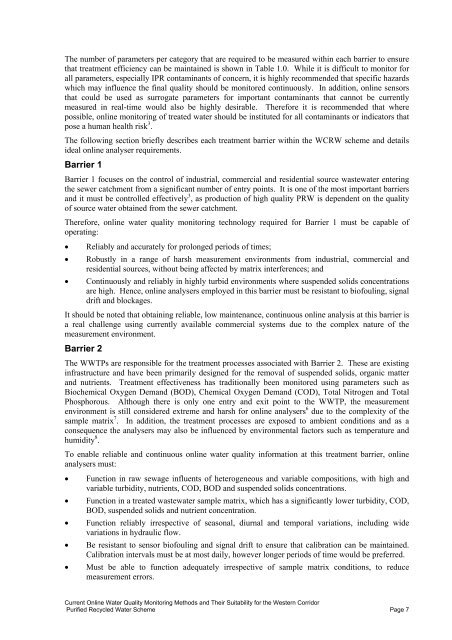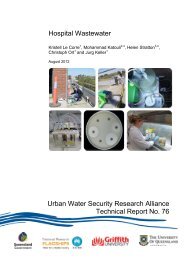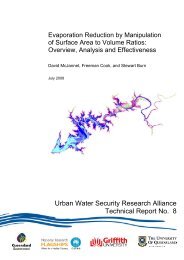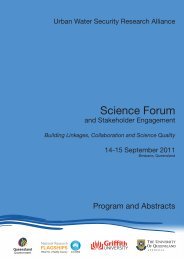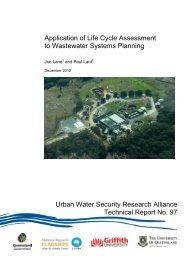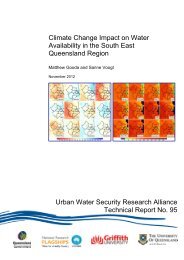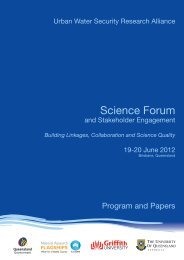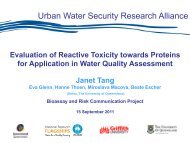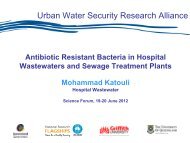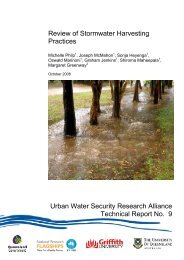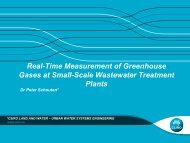Current online water quality monitoring methods and their suitability ...
Current online water quality monitoring methods and their suitability ...
Current online water quality monitoring methods and their suitability ...
You also want an ePaper? Increase the reach of your titles
YUMPU automatically turns print PDFs into web optimized ePapers that Google loves.
The number of parameters per category that are required to be measured within each barrier to ensurethat treatment efficiency can be maintained is shown in Table 1.0. While it is difficult to monitor forall parameters, especially IPR contaminants of concern, it is highly recommended that specific hazardswhich may influence the final <strong>quality</strong> should be monitored continuously. In addition, <strong>online</strong> sensorsthat could be used as surrogate parameters for important contaminants that cannot be currentlymeasured in real-time would also be highly desirable. Therefore it is recommended that wherepossible, <strong>online</strong> <strong>monitoring</strong> of treated <strong>water</strong> should be instituted for all contaminants or indicators thatpose a human health risk 3 .The following section briefly describes each treatment barrier within the WCRW scheme <strong>and</strong> detailsideal <strong>online</strong> analyser requirements.Barrier 1Barrier 1 focuses on the control of industrial, commercial <strong>and</strong> residential source waste<strong>water</strong> enteringthe sewer catchment from a significant number of entry points. It is one of the most important barriers<strong>and</strong> it must be controlled effectively 3 , as production of high <strong>quality</strong> PRW is dependent on the <strong>quality</strong>of source <strong>water</strong> obtained from the sewer catchment.Therefore, <strong>online</strong> <strong>water</strong> <strong>quality</strong> <strong>monitoring</strong> technology required for Barrier 1 must be capable ofoperating:Reliably <strong>and</strong> accurately for prolonged periods of times;Robustly in a range of harsh measurement environments from industrial, commercial <strong>and</strong>residential sources, without being affected by matrix interferences; <strong>and</strong> Continuously <strong>and</strong> reliably in highly turbid environments where suspended solids concentrationsare high. Hence, <strong>online</strong> analysers employed in this barrier must be resistant to biofouling, signaldrift <strong>and</strong> blockages.It should be noted that obtaining reliable, low maintenance, continuous <strong>online</strong> analysis at this barrier isa real challenge using currently available commercial systems due to the complex nature of themeasurement environment.Barrier 2The WWTPs are responsible for the treatment processes associated with Barrier 2. These are existinginfrastructure <strong>and</strong> have been primarily designed for the removal of suspended solids, organic matter<strong>and</strong> nutrients. Treatment effectiveness has traditionally been monitored using parameters such asBiochemical Oxygen Dem<strong>and</strong> (BOD), Chemical Oxygen Dem<strong>and</strong> (COD), Total Nitrogen <strong>and</strong> TotalPhosphorous. Although there is only one entry <strong>and</strong> exit point to the WWTP, the measurementenvironment is still considered extreme <strong>and</strong> harsh for <strong>online</strong> analysers 6 due to the complexity of thesample matrix 7 . In addition, the treatment processes are exposed to ambient conditions <strong>and</strong> as aconsequence the analysers may also be influenced by environmental factors such as temperature <strong>and</strong>humidity 8 .To enable reliable <strong>and</strong> continuous <strong>online</strong> <strong>water</strong> <strong>quality</strong> information at this treatment barrier, <strong>online</strong>analysers must:Function in raw sewage influents of heterogeneous <strong>and</strong> variable compositions, with high <strong>and</strong>variable turbidity, nutrients, COD, BOD <strong>and</strong> suspended solids concentrations.Function in a treated waste<strong>water</strong> sample matrix, which has a significantly lower turbidity, COD,BOD, suspended solids <strong>and</strong> nutrient concentration.Function reliably irrespective of seasonal, diurnal <strong>and</strong> temporal variations, including widevariations in hydraulic flow.Be resistant to sensor biofouling <strong>and</strong> signal drift to ensure that calibration can be maintained.Calibration intervals must be at most daily, however longer periods of time would be preferred.Must be able to function adequately irrespective of sample matrix conditions, to reducemeasurement errors.<strong>Current</strong> Online Water Quality Monitoring Methods <strong>and</strong> Their Suitability for the Western CorridorPurified Recycled Water Scheme Page 7


